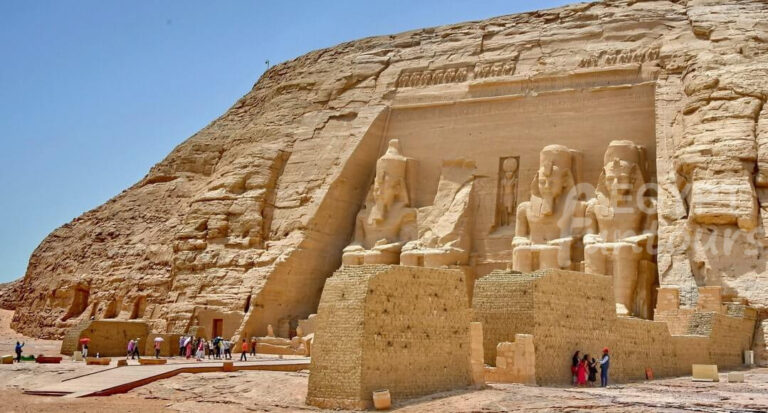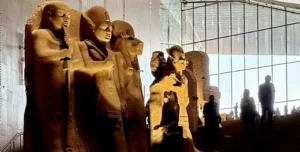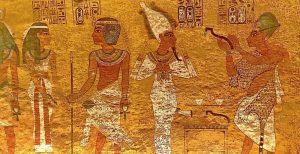The Ancient Egyptian Lotus Flower
The ancient Egyptian lotus flower holds a significant place in culture, symbolizing various aspects of life, spirituality, and the natural world. This report synthesizes key points from multiple sources to comprehensively understand the lotus flower’s importance in ancient Egypt.

Symbolism and Religious Significance
The lotus flower was a prominent religious symbol in ancient Egypt. It represented beauty, life, and resurrection. Egyptians associated it closely with the sun and creation. This was due to its daily cycle of blooming in the morning and closing at night, which mirrored the sun’s journey. In Egyptian mythology, the world emerged from a vast sea called Nun. A lotus flower bud rose above the water’s surface, symbolizing the birth of life.
The lotus was also linked to several gods, most notably Nefertem, the god of the lotus blossom and perfumes. People often showed Nefertem with a lotus on his head or as a child seated on a lotus blossom. This symbolized rebirth and the sun god Ra. The flower also has a connection with Horus, who people occasionally showed as a child sitting on a lotus with his mother.
Ancient Egyptian art and artifacts extensively featured the lotus flower. It appeared in hieroglyphics, tomb decorations, and various forms of jewelry. An example is the gold “lotus flower” pendant from Queen Nefertiti’s time. The blue lotus, in particular, was commonly depicted in art and was known for its sweet fragrance.
The flower’s ability to grow in murky, muddy waters and emerge pristine and pure symbolizes rising above challenges and obstacles to achieve greatness. This unique characteristic makes the lotus an emblem of purity and perseverance. It embodies the spirit of overcoming adversity to achieve greatness.
Other Flowers and Plants of Ancient Egypt
The Blue Lotus (Nymphaea caerulea) was one of the most important flowers in ancient Egypt. Egyptians associated it with the sun god, Ra. They also believed it had healing properties. The Blue Lotus was used in various religious ceremonies and was a popular motif in Egyptian art.
The White Lotus (Nymphaea lotus) was another important flower. It was associated with the god of creation, Atum. People also believed it had medicinal properties. The White Lotus was often depicted in art. Its petals were used to make perfumes.
The Red Lotus (Nelumbo nucifera) was a rare flower. It was highly valued for its beauty and symbolism. It was associated with the god of the afterlife, Osiris. Egyptians often used it in funerary art and rituals.
The Mandrake (Mandragora officinarum) was a mystical plant. People believed it had magical properties. It was often used in love spells and was associated with the god of fertility, Min.
Papyrus (Cyperus papyrus) was a common plant. Egyptians used it for many purposes, including making paper, building boats, and weaving baskets. It also had an association with the goddess of wisdom, Seshat. People often used it in religious ceremonies.
Jasmine (Jasminum officinale) was a popular flower. It had an association with love and sensuality. Its sweet fragrance was used for perfumes. People often scattered its petals on the beds of newlyweds.
The Marigold (Tagetes erecta) was a common flower. It had an association with the sun god, Ra. Egyptians often used it in religious ceremonies and believed it had medicinal properties.
The Acacia (Acacia nilotica) was a highly valued tree. It was known for its durable wood and medicinal properties. It was associated with the god of death and rebirth, Osiris. Its wood was often used to build coffins.
Botanical Characteristics and Usage
Ancient Egypt was home to two main types of lotus: the white Nymphaea Lotus and the blue Nymphaea coerulea. The blue lotus was more abundant and often appeared in art. The flower’s ability to regulate its own temperature, similar to warm-blooded animals, added to its mystical quality.
The White Lotus (Nymphaea lotus) held significant cultural and practical importance in ancient Egypt. This flower had a close association with the god of creation, Atum, symbolizing rebirth and creation. Beyond its religious symbolism, people believed the White Lotus had medicinal properties, making it a valuable plant in ancient Egyptian medicine. White Lotus flowers often appeared in Egyptian art, which emphasized their cultural relevance. People also used the petals of the White Lotus in perfume-making, which showed their practical use in daily life.
Lotus Flower in Weddings
The Egyptian Lotus Flower holds a significant place in Egyptian weddings. It embodies deep cultural symbolism and tradition.
At the heart of its use in weddings, the Egyptian Lotus symbolizes growth and transformation. Much like the flower that rises from the murky waters, couples use the lotus to reflect their journey together. It represents overcoming challenges and emerging stronger.
Decorative Element
Brides often include the lotus flower in their bouquets. Its distinctive, elegant petals make for stunning centerpieces and floral arrangements. This adds a touch of traditional beauty to the ceremony. The flower has a frequent usage in ceremonial decor. From altar adornments to decorative garlands, the lotus enhances the aesthetic while enriching the celebration with its profound meaning. Couples also celebrate their union with lotus-themed jewelry. Necklaces, bracelets, and earrings featuring the lotus are popular choices. They serve as both a fashion statement and a symbol of their new journey together.
Wedding Attire
In some traditions, the lotus motif is intricately woven into the fabric of wedding attire. Brides and grooms might wear garments that feature lotus patterns, representing purity and the blossoming of their relationship.
Emblem of New Beginnings
In summary, the Egyptian Lotus Flower is more than just a decorative element in Egyptian weddings. It is an emblem of new beginnings, growth, and the beautiful transformation that marriage brings. This symbolic flower enriches the wedding experience, linking modern celebrations with ancient traditions.
Red Lotus in Ancient Egypt
The Red Lotus (Nelumbo nucifera) is a vibrant flower that held significant value in ancient Egyptian culture. This rare plant was highly prized not just for its striking beauty. It also had a deep place in the spiritual and religious practices of the time.
Symbolism and Spiritual Significance
The Red Lotus also has a connection to the god Osiris, the deity of the afterlife and resurrection. This connection raised the flower’s status within Egyptian society. The flower’s presence was notable in funerary art and rituals. It often symbolized rebirth and eternal life, making it a staple in tomb decorations and burial ceremonies. The importance of the Red Lotus extended beyond mere beauty. It became part of the very fabric of ancient Egyptian beliefs and customs.
Practical uses
Beyond its symbolic significance, the lotus had practical uses. Egyptians ate its roots as food. They also used its flowers to decorate utensils and tombs. People also used the intoxicating scent of the blue lotus for its inebriating effects. It played a role in religious and cultural practices.
Modern Context and Legacy

Due to climate change, you now primarily find the lotus in Egypt’s Delta region. Despite this, celebrating its legacy continues. It remains a powerful symbol of Egypt’s rich cultural heritage. Its association with rebirth and regeneration makes it a popular choice for tattoos, jewelry, and other decorative items.
Cultural Significance
The Egyptian Lotus Flower is common in Egyptian weddings. Here, it symbolizes the couple’s journey of growth and transformation together. These modern applications show the flower’s lasting symbolic importance.
Global Influence
The symbolism of the lotus flower extends beyond Egypt, influencing various cultures and religions. In Hinduism and Buddhism, the lotus represents divine beauty, purity, and spiritual growth. The Chinese have perfected its cultivation techniques over centuries, where it symbolizes purity and resilience.
Historical and Modern Connection
Egyptian flowers are a beautiful and essential part of the country’s cultural heritage. From the national flower of Egypt to the ancient Egyptian flowers that adorned the tombs and temples of pharaohs, these flowers hold deep symbolic meaning and significance. The Egyptian Lotus Flower, with its association with rebirth and regeneration, is a powerful symbol that continues to inspire people to this day.
Lotus Flower and the Nile River

The lotus flower, particularly the blue and white varieties, has a deep connection with the River Nile and ancient Egyptian culture. This report explores the flower’s significance based on its habitat, use, and symbolism.
The lotus flower thrived on the muddy banks of the River Nile. Its roots grew deep into the mud, allowing the flower to rise above the water. This natural habit contributed to its symbolic representation of rising from the depths to bloom in the sunlight. The lotus flower often appeared in ancient Egyptian decorations, hieroglyphics, and temple carvings. It was a common motif in art, symbolizing the unification of Upper and Lower Egypt. It also represented the connection between the underworld and the heavens.
Medicinal and Ritualistic Uses
Ancient Egyptians used the lotus flower in traditional medicine for its calming and sedative effects. They also used it as an aphrodisiac. They steeped the flower in wine and used it in religious ceremonies. This practice helped them reach higher states of consciousness and connect with the divine.
Ancient Egyptians extracted the intoxicating scent of the blue lotus to create perfumes. They believed these perfumes had healing properties. This practice shows the flower’s importance in both daily life and spiritual rituals.
Global Influence
The ancient Egyptian lotus flower’s symbolism extends beyond Egypt. It has influenced various cultures and religions. In Hinduism and Buddhism, the lotus represents divine beauty, purity, and spiritual growth. The Chinese perfected its cultivation techniques over centuries. There, it symbolizes purity and resilience.
The Acacia Tree: A Pillar of Ancient Egyptian Culture
The Acacia tree, scientifically known as Acacia nilotica, held great importance in ancient Egypt. Egyptians highly valued this tree for its strong wood and versatile medicinal properties. Its wood was famous for its durability, making it a preferred material for various constructions, including coffins.
The Acacia tree has a connection with Osiris, the god of death and rebirth. This connection gave the tree a spiritual significance that went beyond its practical uses. People believed Acacia wood possessed protective qualities, making it an ideal choice for items related to the afterlife.
- Durability: The wood of the Acacia tree was extremely strong, suitable for long-lasting construction.
- Medicinal Uses: Ancient Egyptians used various parts of the Acacia tree for their healing properties.
- Spiritual Connection: Linked with Osiris, the tree symbolized immortality and protection.
Acacia wood’s resilience made it essential for building everyday objects and sacred items. Egyptians crafted furniture, tools, and religious artifacts from this valuable resource. Considered a versatile and symbolic tree, the Acacia played an integral role in both the daily and spiritual lives of ancient Egyptians. This made it a cornerstone in their culture and rituals.
The Ancient Egyptian Lotus Flower
In conclusion, the ancient Egyptian lotus flower was a multifaceted symbol in ancient Egypt, embodying concepts of rebirth, creation, and divine association. Its presence in art, mythology, and daily life underscores its importance in Egyptian culture and its enduring legacy across different civilizations.


























